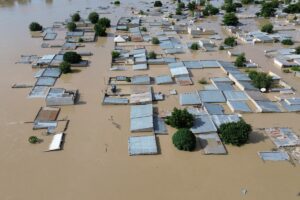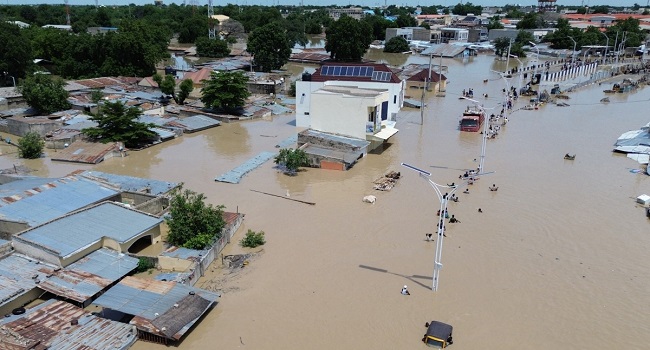The Federal Government has recently issued an important alert to Nigerians regarding the imminent release of water from the Lagdo Dam in Cameroon. This notification was made public in a statement by Umar Muhammed, the Director General and Chief Executive Officer of the Nigeria Hydrological Services Agency (NIHSA). According to the statement, the controlled release of water from the dam is scheduled to begin on September 17.
The release is expected to start at a rate of 100 cubic meters per second (m³/s), which equates to approximately 8.64 million cubic meters per day. This initial discharge is anticipated to increase gradually, potentially reaching 1000 m³/s over the following week. The decision to release the water is largely due to the inflow from the upstream Garoua River, a major contributor to the reservoir and an important tributary to the Benue River.
“The Nigeria Hydrological Services Agency wishes to notify the general public that the authorities of the Lagdo Dam in Cameroon have communicated to the agency that they will initiate controlled water releases at a rate of 100m³/s (8,640,000m³/day) starting today, 17 September 2023,” the statement explained. It further detailed that the water release would progressively escalate depending on the upstream inflow, with a cautious approach to avoid overwhelming the Benue River system. This approach aims to prevent significant flooding downstream in Nigeria, which could otherwise cause severe consequences for communities along the riverbanks.
 However, the NIHSA has reassured the public that there is no immediate cause for alarm. According to Umar Muhammed, the flow levels along the Benue River are still within manageable limits, and the agency does not anticipate major flooding as a result of this release. Nonetheless, he urged states bordering the Benue River to remain vigilant. This includes states such as Adamawa, Taraba, Benue, Nasarawa, Kogi, Edo, Delta, Anambra, Bayelsa, Cross River, and Rivers.
However, the NIHSA has reassured the public that there is no immediate cause for alarm. According to Umar Muhammed, the flow levels along the Benue River are still within manageable limits, and the agency does not anticipate major flooding as a result of this release. Nonetheless, he urged states bordering the Benue River to remain vigilant. This includes states such as Adamawa, Taraba, Benue, Nasarawa, Kogi, Edo, Delta, Anambra, Bayelsa, Cross River, and Rivers.
“While major flooding downstream in Nigeria is not anticipated since the flow levels along the Benue River are still within cautionary limits, it is of utmost importance for all states bordering the Benue River system, namely: Adamawa, Taraba, Benue, Nasarawa, Kogi, Edo, Delta, Anambra, Bayelsa, Cross River, and Rivers, along with the government at all levels (Federal, State, and Local Government Areas) to heighten their vigilance,” Muhammed stated. He emphasized that this vigilance is necessary to implement appropriate preparedness measures, aiming to mitigate any potential flooding impacts that may arise due to an increase in water flow levels in Nigeria’s major rivers during this period.
The agency assured the public that it will continue to closely monitor the flow conditions of the transboundary Benue River and other national inland rivers. Regular updates on water levels across major rivers will be provided to help prevent flood disasters. This careful monitoring will be crucial in ensuring that the gradual release of water from the Lagdo Dam does not lead to an unexpected overflow in the river systems downstream.
The release of water from the Lagdo Dam is a significant event that has, in the past, led to extensive flooding in parts of Nigeria, particularly in communities along the Benue River. However, the current controlled release plan is aimed at managing the water levels more effectively to minimize such risks. It is also a reminder of the interdependence of river systems across national boundaries and the need for effective transboundary water management.
For the residents in the potentially affected areas, this announcement serves as a call to remain aware and prepared. The actions taken by local governments and communities during this period will be crucial in mitigating the impacts of potential flooding. Preparedness measures may include ensuring that drainage systems are clear, raising public awareness about the potential risks, and being ready to implement emergency response plans if needed.
This situation underscores the importance of vigilance and proactive measures in managing natural water systems. While the authorities have assured that the release is being carefully managed to avoid flooding, the unpredictable nature of water flow in such large river systems means that caution is always advisable. The cooperation between Nigeria and Cameroon in communicating and managing the release of water from the Lagdo Dam is a positive example of regional collaboration in addressing shared environmental challenges.
In conclusion, while the release of water from the Lagdo Dam has the potential to affect communities along the Benue River, the controlled and gradual nature of the discharge is designed to mitigate the risk of severe flooding. The Nigeria Hydrological Services Agency’s ongoing monitoring and updates will be crucial in managing this situation and ensuring the safety and well-being of people in the affected areas. Therefore, residents and local governments need to stay informed and take any necessary precautions during this period.




